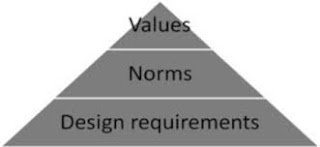In particular, stereotype threats are infecting the STEM community. There is a gender gap in the STEM field, which is being widened by poorly designed products and systems which intentionally or unintentionally perpetuate ill-conceived stereotypes that STEM is a predominantly male field.
In Chapter 3 of "The Cambridge Handbook of Information Ethics", Philip Brey discusses embedded values in technology and how to use value sensitive design (VSD) to account for different values that may appear in technological systems. Brey defines a value to be "idealized qualities or conditions in the world that people find good," and defines an embedded value as a "built-in tendency to promote or harm the realization of a value."
Brey describes VSD as the "most influential" approach in incorporating human values into the design of technologies, as visualized in the figure on the left. VSD "aims to offer a set of methods, tools and procedures for designers by which they can systematically account for values in the design process." I will motivate why VSD is important for the future of bridging the gender gap in the STEM field, and how we can go about doing so.
A study done by Makarova, Aeschlimman, and Herzog (2019) shows that STEM fields are perceived as predominantly masculine among high school students (both male and female). In the analysis of this study, they described that these perceptions are based around gender-based stereotypes and are imposed by the "image of [STEM]". These stereotypes are perpetuated by the nature of the design and formulation of educational resources such as textbooks, which have not only an overrepresentation of male figures in science, but also stereotypical portrayals of science and scientists (Makarova, Aeschlimman, Herzog, 2019).
This study necessitates the use of VSD in STEM education, but how exactly can we employ VSD to combat these social inequities?
Flanagan, Howe, and Nissenbaum's paper "Values at Play: Design Tradeoffs in Socially-Oriented Game Design" lays out a systematic approach to designing a system in which VSD can be used to counteract social inequities in the STEM field. They designed and created a project called RAPUNSEL, which is an educational video game made to help middle-school girls learn how to program in a socially-oriented environment. Their goals in this project were to increase the interests of young women in STEM related fields, and to analyze how VSD played a role in the success of the game.
The process for implementing VSD that they laid out was as follows:
(1) Create a list of relevant values
(2) Check functional components of system for value conflicts
(3) Work through value conflicts for each functional component of model, categorize the model, incorporate feedback from others, ask specific questions, and keep cycling through this.
(4) Verify that desired values are embedded in the system while undesired values are not
The use of this process with VSD allowed RAPUNSEL to incorporate the necessary values for middle-school girls to succeed and become interested in learning more in the STEM field. Being more critical toward the values within educational technologies can help diminish this gender gap in STEM.
The RAPUNSEL project showcases an example in support of how important VSD is in technology, as proposed by Brey. There is still much work to be done to mend this gender gap, but the results show promising evidence of a hopeful future.
Flanagan, M. , Howe, D., & Nissenbaum, H., Values at Play: Design Tradeoffs in Socially-Oriented Game Design (2005)
Makarova, E., Aeschlimman, B., & Herzog, W., The Gender Gap in STEM Fields: The Impact of the Gender Stereotype of Math and Science on Secondary Students' Career Aspirations (2019)


No comments:
Post a Comment
Note: Only a member of this blog may post a comment.